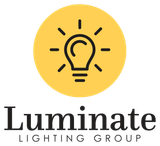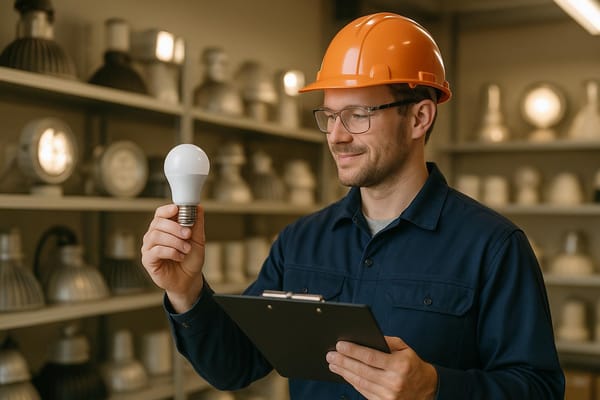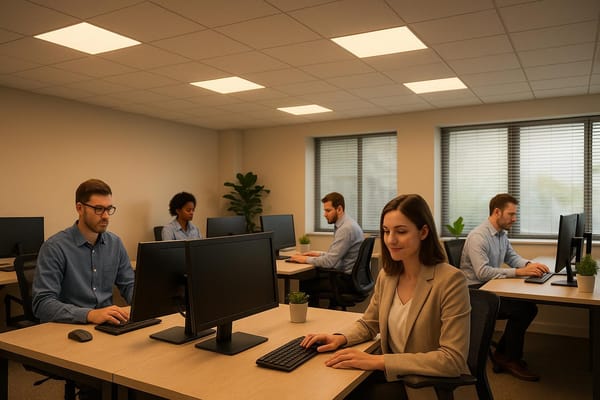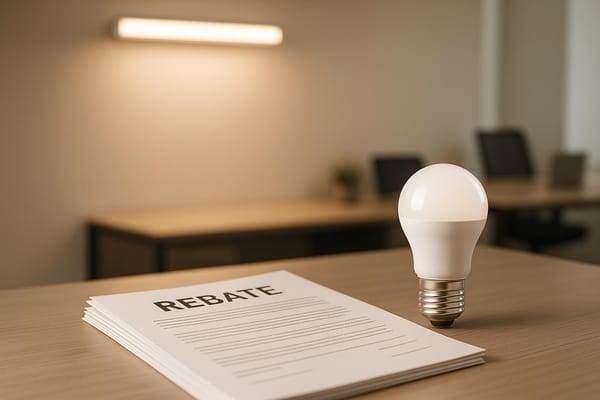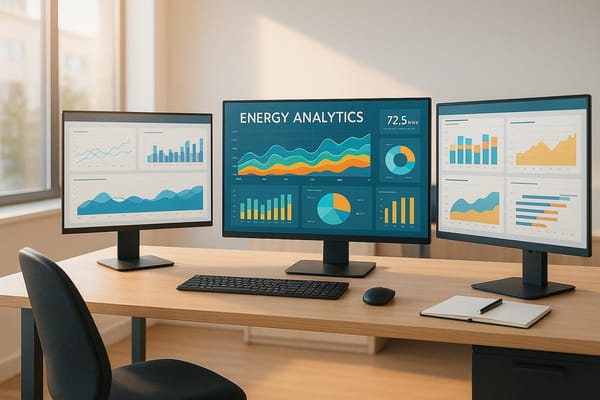How to Plan a Commercial LED Lighting Upgrade
Learn how to effectively plan a commercial LED lighting upgrade to enhance efficiency, cut costs, and comply with energy codes.
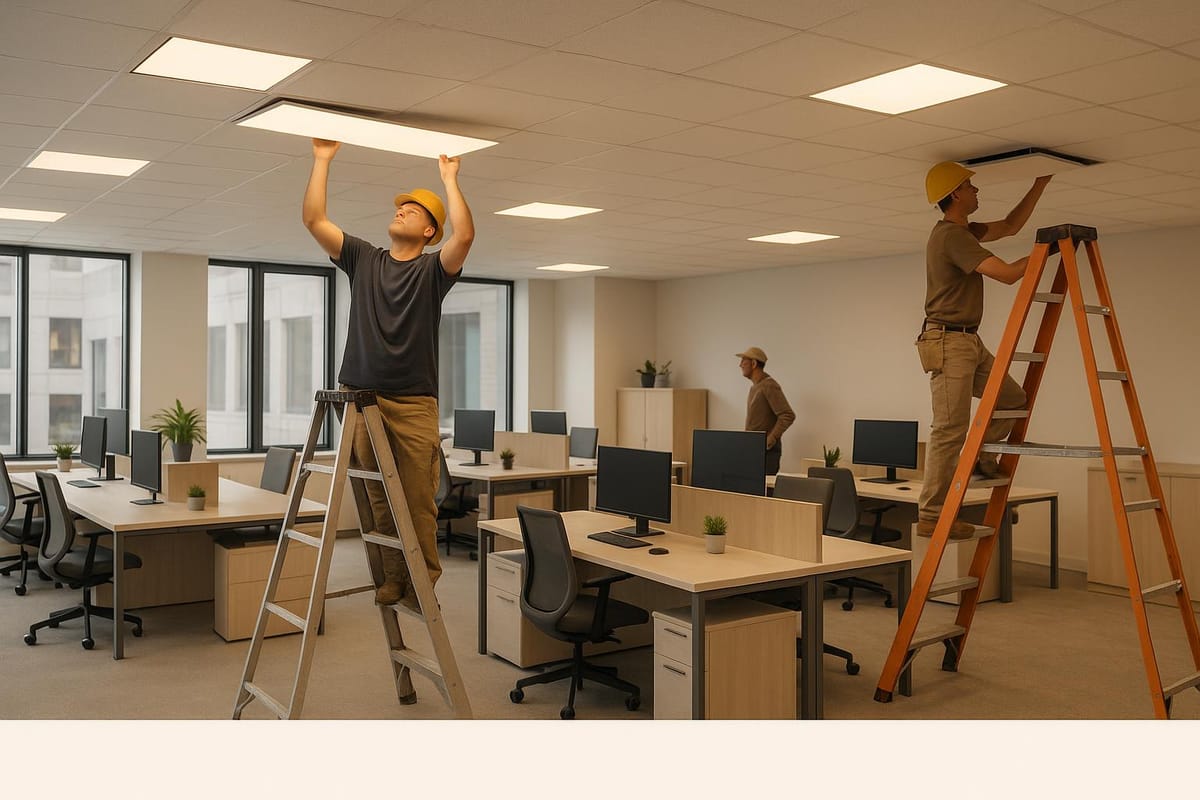
Switching to LED lighting in commercial spaces can cut energy use by up to 90%, reduce maintenance costs, and improve lighting quality. LEDs last longer, generate less heat, and lower cooling expenses, making them a cost-effective and energy-efficient choice. Here's how to plan your upgrade:
-
Step 1: Audit Your Current System
Evaluate fixtures, energy use, and operating patterns to identify inefficiencies and prioritize upgrades. -
Step 2: Define Goals
Focus on energy savings, better light quality, or reduced maintenance. Set clear objectives based on your needs. -
Step 3: Explore Rebates
Research utility rebates to offset costs. Many programs offer incentives, especially for energy-efficient LEDs. -
Step 4: Choose the Right LEDs
Select fixtures based on lumens, color temperature, and compatibility with your space and existing systems. -
Step 5: Calculate Savings
Estimate energy reductions and ROI. LEDs typically pay for themselves within 2–6 years. -
Step 6: Ensure Compliance
Follow energy codes like ASHRAE 90.1 or Title 24 to avoid fines and delays. -
Step 7: Add Smart Controls
Use occupancy sensors or daylight harvesting to cut energy use by up to 50%.
LED Commercial Lighting Installation By MASTER ELECTRICIAN! | Indoor and Outdoor Fixtures
Assess Your Current Lighting System
Before diving into an upgrade, it's important to take a close look at your current lighting setup. A lighting audit - a detailed evaluation of your building's lighting system - helps identify inefficiencies and suggests areas that could benefit the most from improvements. This step establishes a baseline, giving you the data you need to calculate potential savings and make informed decisions about where LED upgrades will have the greatest impact.
Gathering accurate information about energy use, fixture types, and operating patterns is key. While this process takes time, it ensures your upgrade focuses on the right areas, maximizing both efficiency and return on investment. With this foundation in place, you can proceed to a thorough lighting audit to pinpoint specific areas for improvement.
Conduct a Lighting Audit
Start by defining your goals for the upgrade. Whether you're looking to cut energy costs, improve light quality, or reduce maintenance needs, clearly outline your objectives and prioritize them. Then, perform a physical inventory of your lighting system. Take note of fixture counts, types, wattage, lumen output, condition, and average operating hours.
Equip yourself with tools like a camera, tape measure, digital laser, light meter, and an audit form. Use the camera to document fixture locations and conditions, while the light meter will provide precise measurements of current lighting levels. This documentation is crucial for identifying inefficiencies and planning upgrades.
Pay special attention to "burn hours" - the average number of hours per day that lights are in use. These numbers directly affect energy consumption calculations. For example, a warehouse operating 12 hours a day will have vastly different needs compared to a conference room that's only used sporadically.
Also, review energy bills, operating hours, and seasonal variations. Spikes in energy usage can signal inefficient lighting or areas where lights are left on unnecessarily. Utility bills can serve as a baseline for tracking savings after your upgrades. Don’t forget to gather feedback from employees and management; they may point out problem areas that aren't immediately obvious during your inspection.
Find Inefficiencies
After documenting your system, it's time to uncover problem areas. Watch out for flickering or dim lights, buzzing noises, poor light output, or emergency lights that don’t work. Older lighting technologies like incandescent and fluorescent bulbs are especially inefficient, consuming excessive energy compared to modern options. These outdated systems are prime candidates for LED upgrades, as LEDs use up to 90% less energy and last up to 25 times longer than traditional incandescent bulbs.
Inspect fixtures for damage, discoloration, or mismatched color temperatures, as these issues can reduce light quality and create an uncomfortable environment. Uneven lighting can also cause glare and shadows, leading to safety concerns and visual strain. Addressing these inefficiencies often involves more than just replacing bulbs - it’s about improving the overall quality and functionality of your lighting system.
If you notice flickering lights, check for loose bulbs or wiring issues. Patterns of flickering may indicate deeper electrical problems. Dust, corrosion, and damage to fixtures can also reduce efficiency and lifespan, so include these factors in your assessment.
Even simple maintenance can make a big difference. Cleaning fixtures, for example, can boost light output by up to 30% without increasing energy use. Regular upkeep of commercial lighting systems can cut energy consumption by as much as 50%, making maintenance a critical part of your evaluation.
Review Operating Schedules
Understanding how and when your lighting system operates is essential for optimizing its efficiency. Many facilities waste energy by running lights during unoccupied hours or failing to adjust schedules to match seasonal changes in occupancy.
Consider implementing lighting controls that operate on a schedule - turning lights on just before opening and off after closing. Smart lighting controls can help ensure lights are only on when needed. Review your operating hours and identify mismatches, such as lights running during unoccupied times.
Adjusting lighting schedules to align with actual occupancy patterns can significantly improve efficiency. For example, conference rooms often remain lit during off-peak times, or warehouse lighting may operate at full capacity even when activity is low. Seasonal variations, like reduced office use in summer or increased retail activity during the holidays, should also be accounted for. Your lighting system should adapt to these changes rather than following a fixed schedule year-round.
Find Energy-Saving Opportunities
Now that your lighting audit is complete, you have the insights needed to identify where LED upgrades will make the biggest difference. Focus on areas with the highest energy consumption and continuous operation, and don’t forget to explore financial incentives to help offset upfront costs.
Analyze Energy Consumption
Your audit highlights energy-heavy areas that are prime targets for LED upgrades. Look at 24/7 spaces like parking garages, stairwells, and common areas, as these locations offer significant opportunities for cutting energy use.
Pay close attention to high-bay and low-bay fixtures commonly found in warehouses, gyms, and large commercial spaces. These fixtures not only consume a lot of energy but are also challenging to maintain, making them excellent candidates for LED replacements.
If you still have incandescent or halogen lights in use, prioritize those upgrades. LEDs use 75–80% less energy than incandescent bulbs and 65% less than halogen lamps. Plus, while older technologies waste 80–90% of their energy as heat, LEDs stay cool, making them far more efficient.
Spaces with outdated HID or fluorescent systems often suffer from poor lighting quality. Upgrading to LEDs in these areas can cut energy costs by 40–60%. Once you’ve pinpointed these high-impact areas, investigate financial incentives to make these upgrades even more cost-effective.
Research Utility Rebates and Incentives
Financial incentives can make your LED upgrades much more affordable. In fact, 77% of the U.S. is currently covered by active lighting rebate programs, and rebate amounts are expected to increase in 2025. For example, commercial lighting rebates rose by 3% across all LED product categories in 2025.
Here’s a snapshot of average rebate amounts from 2024:
- LED tubes: $4 per tube
- 2x4 troffers: $33 per fixture
- Parking garage fixtures: $94 per fixture
- HID screw-in bulbs: $53 per bulb
- Pole lights: $135 per light
Some regional programs offer even more. Arizona’s Salt River Project (SRP) provides rebates of $0.25–$0.35 per watt for qualifying interior LEDs and $0.15 per watt for exterior LEDs. Energize Connecticut offers rebates ranging from $25 for basic 2x4 troffers to $90 for models with advanced lighting controls.
Keep an eye out for bonus programs that can boost rebates by 10–100% during specific periods. In 2025, 5% of rebate programs launched with these bonuses already included.
"Despite concerns of LEDs reaching market saturation and legislation restricting fluorescent lamp sales passed in 15 states, commercial lighting rebates are still as strong as ever." - BriteSwitch
Don’t overlook smart lighting controls either. Networked lighting controls (NLCs) can reduce energy use by up to 47%. Options like dimmable LEDs, automated controls, and energy management software not only save energy but can also maximize your rebate potential. Start your research early and work with program administrators to ensure you meet all eligibility criteria.
Set Clear Upgrade Goals
Once you’ve analyzed your energy use and explored rebate options, set specific goals for your upgrades. Energy efficiency is usually the top priority - LEDs can slash energy consumption by up to 75% and last 25 times longer than traditional bulbs.
Beyond efficiency, LEDs can enhance the look and feel of spaces. They offer better color rendering, eliminate flicker, and provide consistent light output - improvements that matter in offices, retail stores, and healthcare facilities.
You’ll also want to consider compliance with energy codes. States like California, Oregon, and Colorado are set to ban compact and linear fluorescent tubes starting in 2025.
When setting goals, review your historical energy consumption data and compare it to industry benchmarks to establish realistic targets.
"The very first stage of any energy management plan is understanding where you are - your assets, utilization, and how much it costs." - Tony Parkinson, Chair of the Global Sustainability Council at City Facilities Management
Involve key stakeholders, including building owners, facility managers, and occupants, in your planning process. This ensures your goals align with operational needs, audit findings, and available rebate opportunities.
Choose the Right LED Solutions
Now that you've set your goals, it's time to pick LED solutions that align with the specific needs of your commercial space. This step involves understanding fixture specifications, prioritizing quality and warranties, and knowing when to call in experts for complex installations.
Check Fixture Specifications
Focus on lumens and efficacy, not wattage. Instead of comparing wattage, check the delivered lumens (the actual light output) and efficacy (lumens per watt). Aim for commercial-grade LEDs with an efficacy of 120+ lumens per watt. For example, replacing a single 400W metal halide fixture with an LED alternative could save over $300 annually in energy and maintenance costs.
Choose the right color temperature for your space. Color temperature can significantly affect how a space feels and functions:
- 3000K: Warm lighting, ideal for hospitality and retail.
- 4000K: Neutral lighting, perfect for offices and schools.
- 5000K: Cool white light, suited for warehouses and parking areas.
Pay attention to Color Rendering Index (CRI). CRI measures how accurately colors appear under the light. Most commercial spaces do well with 80+ CRI, but areas like retail stores, art galleries, or healthcare facilities may need 90+ CRI for precise color representation. High R9 values are especially important for rich reds and natural skin tones.
Check IP ratings for installation suitability. IP ratings indicate a fixture's resistance to dust and water:
- IP20: Indoor, dry areas.
- IP44: Splash-prone zones.
- IP65: Outdoor or industrial environments.
- IP66/IP67: Heavy-duty, water-resistant applications.
Ensure dimming compatibility. Before purchasing, confirm that your LEDs work with existing dimming systems like 0-10V, DALI, or phase-cut dimmers to avoid costly mistakes [24].
| Application | Recommended Features | Specifications | Price Range |
|---|---|---|---|
| Office | Low glare, neutral white | 3500–4000K, 80+ CRI | $50–$150 |
| Retail | High CRI, accent options | 3000–3500K, 90+ CRI | $75–$250 |
| Warehouse | High efficacy + controls | 4000–5000K, 120° beam | $150–$500 |
| Outdoor | Rugged, photocell-ready | 4000K, IP65+ | $100–$600 |
| Healthcare | Cleanable, high CRI | 3500–4000K, 90+ CRI, IP54+ | $150–$300 |
Prices depend on brand, volume, and features.
Match beam angle to ceiling height. For ceilings over 20 feet, use high bay fixtures; for ceilings between 12 and 20 feet, go with low bay options. This ensures even light distribution for your space.
Finally, always choose fixtures that meet quality and warranty standards.
Consider Warranties and Quality
Look for long warranties. A 5+ year warranty is a good sign of manufacturer confidence, as commercial LED fixtures generally last 25,000–50,000 hours. Reliable manufacturers back their products with solid warranties and helpful customer support.
Certifications matter. Look for these certifications to ensure safety and performance:
- UL and ETL: Verify electrical safety and fire resistance in the U.S..
- DLC: Confirms energy efficiency, light output, and color quality. DLC Premium products may also qualify for higher utility rebates.
- Energy Star: Helps reduce energy consumption and may unlock rebates.
- FCC: Ensures minimal electromagnetic interference [44,45].
"LED standards and certifications play a crucial role in guaranteeing that lighting products meet stringent requirements for performance, reliability, and safety." – LightUp
Thermal management impacts longevity. DLC Premium fixtures often have better heat dissipation, which extends their lifespan and maintains light output. Poor thermal management can shorten an LED's life and reduce efficiency over time.
For warranty claims, keep invoices and take photos of the installed fixtures. Test emergency lighting by turning off the breaker to ensure they function properly.
For projects with unique challenges, professional guidance can make all the difference.
Get Professional Help for Custom Solutions
When standard specifications and warranties aren’t enough, professional design and installation can ensure your lighting system performs at its best. Complex spaces often require tailored solutions. For instance:
- Offices need bright, even lighting for productivity.
- Retail stores benefit from a mix of ambient, accent, and task lighting to showcase merchandise and create an inviting atmosphere.
Lighting designers can use software like Visual or DIALux to create photometric layouts, ensuring proper fixture placement and counts before installation.
Electrical compatibility is critical. Voltage, current, and dimming systems must align with your existing setup. For fixtures with integrated drivers, replacing them with LED-compatible versions may be necessary.
Avoid hazards with professional installation. Licensed electricians ensure proper grounding, electrical protection, and load calculations, preventing costly mistakes or safety issues.
Custom solutions tackle unique needs. Whether it’s circadian lighting for 24/7 operations, specialized mounting requirements, or integration with building automation systems, professionals can handle it all. They can also assist with utility rebate applications and ensure documentation is in order.
Luminate Lighting Group offers turnkey commercial LED solutions, including energy audits, photometric layouts, fixture specifications, code compliance checks, and full installations. Their approach maximizes energy savings while meeting safety and performance standards.
For projects involving multiple fixture types, complex controls, or specialized lighting needs like those in healthcare facilities, professional help is a smart investment.
Calculate Energy and Cost Savings
Switching to LED lighting isn't just about better illumination - it's also a smart financial move. Here's how you can calculate the energy and cost savings to ensure your upgrade makes solid business sense.
Estimate Energy Usage Reductions
Start with the basics. Let’s say you replace a 400W metal halide bulb with a 150W LED. This swap drastically cuts energy use. At an electricity rate of $0.20 per kWh, each bulb could save you about $146 annually. Now, imagine scaling this to a commercial space with 100 fixtures - your yearly savings could hit $14,600.
On average, LEDs reduce energy consumption by 65%–80%. In some cases, a 100W LED can replace a 1,000W halogen bulb, slashing energy use by up to 90% .
Lighting typically accounts for 20–30% of a commercial building's electricity bill. After switching to LEDs, lighting costs often drop to just 4–6% of total energy expenses. That’s a significant reduction.
To refine your savings estimates, factor in your building's operating hours and usage patterns. Smart lighting systems can further optimize energy use by adjusting based on occupancy or natural daylight. These energy savings are key to assessing the financial return of your project.
Calculate ROI and Payback Period
When calculating ROI, don't just focus on energy savings. Include reduced maintenance costs and any utility rebates. For instance, replacing a 90W PAR 38 bulb with a 14W LED PAR 38 (operating 12 hours a day for 250 days) saves about $70.56 per bulb annually. If each LED costs $40 and you’re upgrading 100 bulbs, your payback period is just over six months, with an ROI of 76.4%.
Typically, LED lighting upgrades pay for themselves within 2 to 6 years. However, some projects, like the PKK Lighting case study, have seen payback periods of less than a year.
Utility rebates can make these upgrades even more appealing. In some instances, rebates combined with energy savings have delivered ROIs as high as 129% in the first year.
For the most accurate ROI calculation, consider all costs - materials, installation, electrical work, permits, and inspections. And remember, the savings don’t stop there.
Account for Maintenance Savings
One of the most overlooked benefits of LEDs is their longevity. LEDs typically last 50,000 to 100,000 hours, compared to just 2,000 hours for incandescent bulbs and 4,000 hours for halogen lights. A high-quality LED bulb can last 3 to 5 times longer than a CFL and up to 30 times longer than an incandescent bulb. For businesses with numerous fixtures, this means fewer replacements and significantly lower labor costs.
Let’s break it down. A 90W halogen PAR 38 bulb, replaced twice a year at $15 annually, costs far more than a 14W LED PAR 38, which needs replacing only 0.06 times annually at about $1.11. That’s a yearly savings of $13.90 per bulb.
Beyond the cost of bulbs, you’ll save on labor and disposal fees. With LEDs requiring far fewer replacements, maintenance costs drop dramatically. To get a clear picture of your long-term savings, document your current maintenance expenses, including bulb purchases, labor, equipment rentals, and disposal fees. These savings add even more value to your LED upgrade.
Ensure Compliance and Add Smart Technology
Wrapping up your LED upgrade means ensuring compliance with energy codes and integrating smart lighting controls. These steps not only help you meet regulations but also maximize efficiency and long-term savings.
Meet Energy Code Requirements
Understand key energy codes. In the U.S., commercial LED lighting upgrades are primarily guided by ASHRAE 90.1 and the International Energy Conservation Code (IECC). These codes are updated every three years to reflect new practices and technologies. The most recent versions are ASHRAE 90.1-2022 (published in January 2023) and the 2021 IECC.
The U.S. Department of Energy uses ASHRAE/IES 90.1-2016 as the national energy standard, but states can modify or adopt parts of these codes. Some states, like California, have developed their own, such as Title 24, which sets specific requirements for dimming and occupancy sensors.
As Charles Knuffke, Systems VP at Wattstopper, notes:
"The California code is written the best and is most readable. California was also the first to regulate mandatory dimming. Title 24's code regarding occupancy sensors is simple and specific. ASHRAE is more complicated, but the efforts behind these different code standards are to harmonize with one another."
Know your local standards. Requirements may vary by state. For instance, commercial 2 ft. x 4 ft. troffers must provide at least 3,000 lumens with a minimum efficacy of 140 lumens per watt, while industrial high bay fixtures must deliver 10,000 lumens at 175 lumens per watt. Additionally, as of August 1, 2023, the DOE mandates that light bulbs sold in retail must produce at least 45 lumens per watt, effectively phasing out incandescent bulbs.
Seek professional advice. Consulting professionals can help you navigate local codes and avoid compliance issues that could lead to delays or fines. With compliance secured, the next step is integrating smart lighting controls.
Add Smart Lighting Controls
Smart lighting controls take your LED upgrade to the next level, creating a system that adjusts to real-time needs. These controls can cut lighting-related energy use by up to 50% and reduce overall lighting costs by 30% to 70%.
Occupancy sensors and daylight harvesting are particularly effective tools. Lighting often accounts for up to 20% of a commercial building's electricity use. Smart systems reduce this by adjusting light levels based on occupancy and available natural light. Research from Pacific Northwest National Laboratory shows that IoT and smart lighting systems can save about 29% in energy.
David Buerer, Director of Product Management at Leviton Lighting & Energy Solutions, highlights their benefits:
"Smart lighting systems offer substantial savings in energy and maintenance costs, with estimates showing up to a 90 percent reduction in lighting energy consumption and a 30 percent to 70 percent cut in overall lighting expenses."
Plan for compatibility. When setting up smart lighting, consider the manufacturer, fixture compatibility, dimming capabilities, and how lighting is grouped and controlled by space and function. Automated scheduling can ensure lights are only on during business hours, further reducing energy use. Smart lighting systems not only save energy but can also lower a building's total energy consumption by 5% to 35% by adjusting temperatures as needed.
Train users and commission properly. To get the most out of these systems, train end users on how to operate them effectively. Smart lighting also helps meet energy code requirements like IECC and ASHRAE 90.1.
Document Upgrades for Future Audits
Thorough documentation is critical for maintaining compliance and tracking the performance of your upgrades. Keep detailed records of audits, fixture specs, energy calculations, and compliance certifications. This information is essential for future audits and ensures that your upgrades align with Department of Energy guidelines and local regulations.
Organize comprehensive records. Include warranty details, installation dates, and maintenance schedules. This helps track performance over time and simplifies warranty claims. Proper documentation is also often required for tax credits and rebates tied to energy efficiency programs.
Additionally, record before-and-after energy consumption data. This not only demonstrates the success of your upgrade but also aids in planning future improvements or expansions. Having this data on hand can be invaluable when considering upgrades for other facilities.
Key Steps for Planning Your LED Upgrade
Planning a commercial LED lighting upgrade requires a well-thought-out approach that balances energy efficiency, cost savings, and operational needs. By following a series of essential steps, you can ensure the project delivers maximum benefits and long-term success.
Start with a thorough assessment. Begin by conducting a detailed lighting audit. This step provides the baseline data you need to understand your current energy usage and identify areas where upgrades can make the biggest impact.
Define your upgrade goals. Once the audit is complete, set clear and specific objectives. These might include improving energy efficiency, upgrading controls, reducing maintenance, or reconfiguring lighting to better suit the space. Think about the main activities in each area and tailor the lighting to enhance visibility, support tasks, improve safety, and meet relevant standards.
Calculate costs and savings. Accurate estimates for costs and potential savings are critical to securing project approval. Keep in mind that LED systems can reduce energy use by up to 75% compared to older systems and have a lifespan of 50,000 to over 100,000 hours. Most projects see a payback period of 18–24 months.
Kyle Kluska, President and CEO of PROLIGHTING, highlights the importance of modern lighting systems:
"Lighting isn't just about flipping a switch anymore - it's about maximizing performance, cutting waste, and future-proofing your space."
Select the right LED solutions and controls. Choose fixtures and lighting controls that meet your specific needs while ensuring they are compatible with your existing systems and any future plans for expansion.
Minimize disruption during installation. To avoid significant downtime or productivity loss, schedule the upgrade during off-peak hours or break the project into phases. For retrofits, consider using retrofit kits to limit ceiling disruption, and ensure the voltage requirements (120V/277V/480V) are met.
Ensure compliance and document everything. Adhere to all relevant building codes and standards. Keep detailed records of the upgrade process for future reference, warranty claims, and maintenance purposes.
Collaborate with professionals. Work with experienced lighting designers, architects, and electricians to ensure a seamless upgrade. Their expertise can help you navigate complex specifications, local codes, and rebate opportunities while optimizing performance and compliance.
As Nina Frye from Regency Supply notes:
"As with any project, details are key to a successful lighting upgrade for industrial and warehouse spaces. Outlining an action plan is a great place to start and can help pinpoint important steps during the process."
FAQs
What should I consider when selecting LED fixtures for a commercial space?
When selecting LED fixtures for a commercial space, pay close attention to the lumen output to achieve the desired brightness while keeping energy costs in check. For spaces like retail stores or offices where accurate color perception is essential, prioritize fixtures with a high color rendering index (CRI) to ensure natural and precise lighting.
It's also important to choose fixtures tailored to the specific needs of the space. For instance, high-bay lights work well in warehouses, while recessed lighting is better suited for offices. Opt for durable designs that can handle the environment - like moisture-resistant options for outdoor or industrial settings. If you're incorporating smart technology, make sure the fixtures support features such as dimming or automated controls for added convenience and energy efficiency.
How can I take advantage of utility rebates and incentives to save money on a commercial LED lighting upgrade?
To cut costs on a commercial LED lighting upgrade, take advantage of utility rebates and incentives offered by energy providers and government initiatives. These programs can make a big difference, often reducing upfront expenses by 50% or more. In some cases, they might even cover the entire cost for eligible projects.
Begin by reaching out to your local utility company or state energy office to see what rebates are available. You’ll typically find two types: prescriptive rebates, which offer fixed amounts for specific upgrades, and custom incentives, which are calculated based on the energy savings your project is expected to achieve. These options not only lower your initial investment but also enhance your overall return.
To make the process easier, consider partnering with rebate management services or consulting professionals who specialize in energy-efficient upgrades. They can help pinpoint all the incentives you qualify for, guide you through program requirements, and ensure you get the maximum savings possible.
What are the key steps to ensure energy code compliance during a commercial LED lighting upgrade?
When planning a commercial LED lighting upgrade in the U.S., it's crucial to ensure your project aligns with energy codes. Start by reviewing key standards like ASHRAE 90.1 and the International Energy Conservation Code (IECC), which are updated every three years to incorporate the latest advancements in energy efficiency and technology.
Follow the manufacturer's installation instructions carefully, and once the system is installed, verify its performance to confirm everything is functioning as expected. Keep detailed records, including compliance reports and test results, to demonstrate adherence to regulations. It’s also a good idea to consult with local authorities or energy consultants to ensure your upgrade meets any specific regional requirements. Staying organized and informed will make the entire process smoother and compliant.

